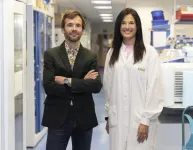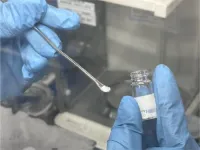(Press-News.org) Smoke From Megafires Puts Orchard Trees at Risk
Effects Last Months, Reducing Nut Crop Yields
By Amy Quinton | October 2, 2023
Long-term smoke exposure from massive wildfires lowers the energy reserves of orchard trees and can cut their nut production by half, researchers at the University of California, Davis, found. The smoke can affect trees for months after a megafire, depressing their bloom and the next season’s harvest. This finding reveals a new danger from wildfires that could affect plant health in both agricultural and natural environments.
Nature Plants published the study today (Oct. 2).
“A lot of research focuses on the impact of smoke on humans but there is less study on the effects of smoke on plant health,” said lead author Jessica Orozco, a postdoctoral researcher with the UC Davis Department of Plant Sciences. “Our study suggests that trees are just as vulnerable as humans.”
Dark skies, less energy for trees
Scientists studied almond, pistachio and walnut trees at 467 orchard sites in California’s Central Valley from 2018 to 2022. In 2020, megafires scorched more than 4.2 million acres in California, filling the skies with smoke and ash. At the time, researchers were studying how trees store energy, in the form of carbohydrates, to cope with heat and drought. But Orozco said the team saw an opportunity to study how smoke affects carbohydrate levels.
“Photosynthesis produces carbohydrates, which are critical elements for tree survival,” said Orozco. “Trees need carbohydrates not just to grow but to store energy for when they’re under stress or when photosynthesis isn’t happening.”
Photosynthesis changes under smoke-filled skies. Smoke particles block some sunlight but also reflect light, creating more diffused light. The diffused light can help trees make more carbohydrates. However, Orozco said the study found that while diffused light increased, the smoke was so thick that it likely didn’t compensate for the loss of direct light.
Lingering effects, less yield
The team found that megafire smoke not only reduced the amount of carbohydrates in trees but also caused losses that continued even after the fires were out. This led to nut yield decreases of 15% to as much as 50% in some orchards. The most active time for wildfires also coincides with the time trees start storing carbohydrates to sustain them through winter dormancy and spring growth.
“We were expecting to see some impact especially in the months when the smoke was really dense, but we weren’t expecting the smoke to have such a lingering effect and result in a significant drop in yield,” Orozco said.
Orozco said researchers still don’t know what components in megafire smoke caused the decrease in tree carbohydrates. During the 2020 megafires, the smoke reduced light and increased both ozone and particulate matter levels, all of which affect photosynthesis. One or a combination of these factors could have led to the drop in tree carbohydrates.
Additional authors on the study are Professor Maciej A. Zwieniecki and postdoctoral researcher Paula Guzmán-Delgado of the UC Davis Department of Plant Sciences.
The Almond Board of California, the California Pistachio Research Board, the California Walnut Board and the California Department of Food and Agriculture supported the research.
END
Smoke from megafires puts orchard trees at risk
Effects last months, reducing nut crop yields
2024-10-02
ELSE PRESS RELEASES FROM THIS DATE:
Health Data Research UK and National Research Foundation Singapore formalize landmark partnership in health data science
2024-10-02
Health Data Research UK (HDR UK) and the National Research Foundation Singapore (NRF) are pleased to have signed a Memorandum of Understanding (MoU) today, that formalises a collaborative partnership in healthcare and data science. The partnership will leverage cutting-edge data science and research, with a focus on trustworthy data use to power improvements in healthcare, research and innovation, strengthening existing links between the UK and Singapore.
The MoU was signed by Permanent Secretary for National Research and ...
CNIO researchers propose a new treatment for brain metastasis based on immunotherapy
2024-10-02
CNIO researchers have discovered that cancer perverts certain brain cells, the astrocytes, and causes them to produce a protein that works in favour of the tumour.
A drug, silibinin, inhibits this protein, and could be used to help treat brain metastasis with immunotherapy. A clinical trial is underway.
The work is published in the American Association for Cancer Research's journal Cancer Discovery.
Researchers at the Spanish National Cancer Research Centre (CNIO) propose a new treatment for brain metastases that respond poorly, or not at all, to immunotherapy, and provide a biomarker to predict ...
Discovery of promising electrolyte for all-solid-state batteries
2024-10-02
Often overlooked, rechargeable batteries play an important part in contemporary life, powering small devices like smartphones to larger ones like electric vehicles. The keys to creating sustainable rechargeable batteries include having them hold their charge longer, giving them a longer life with more charging cycles, and making them safer. Which is why there is so much promise in all-solid-state batteries.
The problem so far is discovering which solid electrolytes offer such potential advantages.
In a step toward that goal, an Osaka Metropolitan University research group led by Assistant Professor Kota Motohashi, Associate Professor Atsushi Sakuda, ...
One-minute phone breaks could help keep students more focused in class and better in tests
2024-10-02
Phones can be useful tools in classrooms to remind students of deadlines or encourage more exchange between students and teachers. At the same time, they can be distracting: Students report using their phones for non-academic purposes as often as 10 times a day. Thus, in many classrooms, phones are not allowed.
Now, researchers in the US have investigated if letting students use their phones for very brief amounts of time – dubbed phone or technology breaks – can enhance classroom performance and reduce phone use.
“We show that technology breaks may be helpful for reducing cell phone use in the college classroom,” said Prof Ryan Redner, a ...
New study identifies gaps in menopause care in primary care settings
2024-10-02
CLEVELAND, Ohio (Oct 2, 2024)—Timely identification and treatment of bothersome hot flashes have the potential to improve the lives of many women and save employers countless days of related absenteeism and lost work productivity. Yet, a new study finds that such symptoms are often not documented in electronic health records (EHRs) or not adequately addressed during primary care visits. The study is published online today in Menopause, the journal of The Menopause Society.
Approximately 75% of women experience hot flashes as they go through the menopause transition. Despite the common occurrence of these bothersome ...
Do coyotes have puppy dog eyes? New study reveals wild canines share dog's famous expression
2024-10-02
New research from Baylor University reveals that coyotes, like domestic dogs, have the ability to produce the famous "puppy dog eyes" expression. The study – "Coyotes can do 'puppy dog eyes' too: Comparing interspecific variation in Canis facial expression muscles," published in the Royal Society Open Science – challenges the hypothesis that this facial feature evolved exclusively in dogs as a result of domestication.
The research team, led by Patrick Cunningham, a Ph.D. research student in the Department ...
Scientists use tiny ‘backpacks’ on turtle hatchlings to observe their movements
2024-10-02
New research suggests that green turtle hatchlings ‘swim' to the surface of the sand, rather than ‘dig’, in the period between hatching and emergence. The findings have important implications for conserving a declining turtle population globally.
Published today in Proceedings B, scientists from UNSW’s School of Biological, Earth and Environmental Sciences, used a small device, known as an accelerometer, to uncover novel findings into the behaviours of hatchlings as they emerge from their nests.
Sea turtle eggs are buried in nests 30 – 80cm deep. Once hatched, the newborn turtles make their way to the surface ...
Snakes in the city: Ten years of wildlife rescues reveal insights into human-reptile interactions
2024-10-02
A new analysis of a decade-long collection of wildlife rescue records in NSW has delivered new insights into how humans and reptiles interact in urban environments.
Researchers from Macquarie University worked with scientists from Charles Darwin University, and the NSW Department of Climate Change, Energy, the Environment and Water to analyse over 37,000 records of snake and lizard rescues in the Greater Sydney region between 2011 and 2021.
Their study, Interactions between reptiles and people: a perspective from wildlife rehabilitation records is published in the journal Royal Society Open Science on Wednesday 2 October.
Lead author Teagan Pyne, ...
Costs of fatal falls among US older adults trump those attributed to firearm deaths
2024-10-01
The cost of fatal falls among older people (45-85+) trump those of firearm deaths in the US, finds research published in the open access journal Trauma Surgery & Acute Care Open.
The stark economics and shifting age demographics in the US underscore the urgency of preventive measures, conclude the researchers.
Falls account for around 1 in 5 of all injury-related hospital admissions, and the World Health Organization reports that falls are the second leading cause of unintentional injury deaths worldwide, with the over 65s especially vulnerable, highlight the researchers.
Like falls, firearms related injuries ...
Harmful diagnostic errors may occur in 1 in every 14 general medical hospital patients
2024-10-01
Harmful diagnostic errors may be occurring in as many as 1 in every 14 (7%) hospital patients—at least those receiving general medical care—suggest the findings of a single centre study in the US, published online in the journal BMJ Quality & Safety.
Most (85%) of these errors are likely preventable and underscore the need for new approaches to improving surveillance to avoid these mistakes from happening in the first place, say the researchers.
Previously published reports suggest that current trigger tools for ...
LAST 30 PRESS RELEASES:
National poll: Less than half of parents say swearing is never OK for kids
Decades of suffering: Long-term mental health outcomes of Kurdish chemical gas attacks
Interactional dynamics of self-assessment and advice in peer reflection on microteaching
When aging affects the young: Revealing the weight of caregiving on teenagers
Can Canada’s health systems handle increased demand during FIFA World Cup?
Autistic and non-autistic faces may “speak a different language” when expressing emotion
No clear evidence that cannabis-based medicines relieve chronic nerve pain
Pioneering second-order nonlinear vibrational nanoscopy for interfacial molecular systems beyond the diffraction limit
Bottleneck in hydrogen distribution jeopardises billions in clean energy
Lung cancer death rates among women in Europe are finally levelling off
Scientists trace microplastics in fertilizer from fields to the beach
The Lancet Obstetrics, Gynecology, & Women’s Health: Taking paracetamol during pregnancy does not increase risk of autism, ADHD or intellectual disabilities, confirms new gold-standard evidence review
Taking paracetamol during pregnancy does not increase risk of autism, ADHD or intellectual disabilities
Harm reduction vending machines in New York State expand access to overdose treatment and drug test strips, UB studies confirm
University of Phoenix releases white paper on Credit for Prior Learning as a catalyst for internal mobility and retention
Canada losing track of salmon health as climate and industrial threats mount
Molecular sieve-confined Pt-FeOx catalysts achieve highly efficient reversible hydrogen cycle of methylcyclohexane-toluene
Investment in farm productivity tools key to reducing greenhouse gas
New review highlights electrochemical pathways to recover uranium from wastewater and seawater
Hidden pollutants in shale gas development raise environmental concerns, new review finds
Discarded cigarette butts transformed into high performance energy storage materials
Researchers highlight role of alternative RNA splicing in schizophrenia
NTU Singapore scientists find new way to disarm antibiotic-resistant bacteria and restore healing in chronic wounds
Research suggests nationwide racial bias in media reporting on gun violence
Revealing the cell’s nanocourier at work
Health impacts of nursing home staffing
Public views about opioid overdose and people with opioid use disorder
Age-related changes in sperm DNA may play a role in autism risk
Ambitious model fails to explain near-death experiences, experts say
Multifaceted effects of inward foreign direct investment on new venture creation
[Press-News.org] Smoke from megafires puts orchard trees at riskEffects last months, reducing nut crop yields


